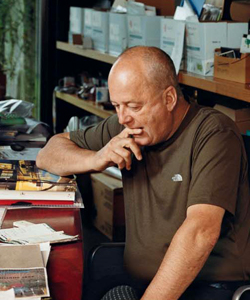Object Lessons
The maestro of Italian design lays out his (flexible!) system for enforcing creative discipline.
By Linda Tischler

Photograph by Emma Hardy
Alberto Alessi, head of the world-famous design factory that bears his name, doesn't like to travel much anymore. And why would he? With an office in Crusinallo, Italy, deep in the heart of the famed Lombardy region -- home to some of the world's most revered design firms -- and a 300-year-old house under renovation in the misty hills around Lake Orta, not much is more appealing than his own casa and cucina. Plus, there's his new hobby as a vintner, raising pinot and chardonnay grapes. "They're difficult to grow," he concedes, "but I'm always looking for a challenge."
The grandson of Giovanni Alessi, who founded the family business in 1921 to make metal products, Alberto, 63, has cultivated a distinctive design aesthetic by pursuing an unlikely vision: that homey domestic items are as worthy of first-rate creative thinking as grand buildings or attention-grabbing chairs. And he has recruited to the cause an ensemble of global design celebrities -- Philippe Starck, Richard Meier, Aldo Rossi, Robert Venturi, Ron Arad, and Ettore Sottsass, to name a few.
"I can't think of any other company that gets close to Alessi's stable of designers, level of quality, and consistency of discovery," says Reed Kroloff, director of the Cranbrook Academy of Art, home of American modernism. Alessi spoke to a jam-packed audience at Cranbrook on a recent, rare trip to the United States. "They were in this game a long time before Target and Ikea, at a higher level of quality. More than anyone else, Alessi understands that design is more than a value-added proposition. It's a fundamental value."
In 1980, Alessi challenged 11 noted architects to create tabletop coffee and tea sets, in which the pots would mimic buildings and the tray would serve as a "piazza." The collection was a design sensation (if not a commercial one: The limited edition sets sold for as much as $25,000) and toured U.S. museums. Then Alessi asked architect Michael Graves to design a teakettle, and Graves's vision caught fire.
The Graves kettle, with its cool blue handle and perky, red-bird-topped spout, became a best-seller -- more than 1.5 million units -- and a design icon. Subsequent knockoffs for Target have sold many more and launched Graves into a second career as a product designer.
Puckish flourish has since become a signature motif in Alessi products. Witness Alessandro Mendini's corkscrews shaped like parrots, devils, and little girls, or Stefano Giovannoni's Orientales collection of playful tablewares in the shape of banana boats, goldfish, and monkeys. Even in this dark recessionary retail climate, those whimsical products are still selling well, says Paolo Cravedi, managing director of Alessi U.S.A., who oversees the company's retail stores in the United States. "Every day, people come in our store and their eyes go wide: Oh, geez, we really needed something like this!"
Alessi stopped in New York on that trip to Cranbrook, with his 8-year-old daughter, and, like any good tourist, hit F.A.O. Schwarz, Toys "R" Us, and the Apple Store. We sat down with Alessi and, after a fine lunch, he shared detailed insights about his company's unique design process.
FC: Many Alessi products seem to have something playful about them. Is that an intentional strategy?
I do not know where this whimsicality came from. [Late Italian designer Achille] Castiglione said to me, "You ask me to design pots and pans. But I never use pots and pans. I don't know where to start!" So maybe in order to balance this strange effect, the designers add some humor. It is not compulsory. I do believe design is a new form of art and poetry, but with the strange destiny of bringing a little bit of joy to people. In that sense, humor probably helps.
What do you look for in recruiting designers?
We are open to anybody. There are 200 good horses in my stable now, and I have to keep them in good shape. I add 5 to 10 new ones every year. Sometimes I follow my own curiosity and contact them. Sometimes designers get in touch with us. Every year, we also organize six or seven workshops with schools we want to work with.
Some folks in your stable -- Philippe Starck, Ron Arad -- have pretty big egos. Any tips for dealing with design divos?
Very basic strategies, like not putting them together.
Do you use much market research to develop your products?
I use the Formula, a mathematic model that I developed at the beginning of the 1990s to decide if we should put a new prototype into production.
That sounds very scientific, very unpoetic!
The Formula was provoked by my brothers and cousins. They wanted to know why I was taking decisions what to do or not to do. Even I didn't know. It was done here. [He touches his stomach.] So I put together all 300 projects that I had helped develop -- some big successes, balanced by big fiascoes. The idea was to understand the reasons for these very unequal lives, and then predict the reaction of our customers.
 Show me how it works.
Show me how it works.
I have two central parameters. [He sketches a grid.] One is called SMI. It means sensation, memory, and imagination, and tries to explore what people mean when they say, "Oh, what a beautiful object!" Beauty alone no longer expresses properly the relations of people with an object. You cannot use beauty when you describe a Starck project, for example. The second parameter is called CL, which means communication language. It measures the ability of a product to communicate something like status or values. A gold Rolex watch, for example, conveys wealth, while a Richard Sapper teakettle indicates cultural sensitivity. Each product can be scored 1 to 5 on each parameter. But we still had several products with the same scores, yet with very unequal lives. So I was obliged to add two more parameters: function and price.
Walk me through how some product would rate on this scale.
Let's take the Philippe Starck squeezer, the Juicy Salif. In the first phase of its life, communication was very strong: a 5. On the function scale, people thought it was an innovation; only later did they discover that it wasn't working so well! Give it a 4. Its price was about $60, for a score of 4, and its SMI, a 5, so its final score was 18. That meant it should sell about 100,000 pieces per year. A score of 12 is very risky -- 1,000 to 2,000 pieces. Since the Formula then was not very precise, you could be a bit wrong, and it could be a disaster. Twenty years later, in the Juicy Salif's second phase, its SMI is the same. [He writes down a 5.] Communication is less. [He writes a 4.] In terms of function, everybody knows it doesn't work, so that is a 2. Price is still reasonable, but we have introduced so many plastic pieces, it is not as impressive. Give it a 3. Today, it is a 14 -- about 50,000 units a year.
How accurate is the Formula?
If it is used on existing typologies, where Alessi has an existing product, it is very precise. If we face a new typology, where we don't have enough experience, like watches, we have to fine-tune it. It is a delicate activity to tune. On existing Alessi typologies, it cannot fail.
What part tends to trip you up?
On the function, we know what works. Same for price. Even in communication, we understand the effect of an object. But where we can misunderstand is in SMI. I can easily be wrong, confusing my personal taste with the taste of my customers.
Do you make the final decisions about products?
Yes. But it's very precious for me to understand the final score of the Formula. Not to manage by, but to understand the risk.
Does this formula work across cultures?
We do not see important differences among our core customers. They are not design victims, but they are surely not average customers. Their reactions are similar, both in Tokyo and Milan.
What has been the most successful product by all these measures?
Michael Graves's teakettle is number one. Starck's Juicy Salif squeezer is another. The first Alessandro Mendini corkscrew. The second Aldo Rossi coffeemaker. Ettore Sottsass's cutlery set. The Orientales plastic objects are also very strong.
If something doesn't measure up, do you eliminate it from the line?
Not necessarily. If I believe that it is an important product for Alessi, I continue. Sometimes I hide the results.
There has been a lot of talk recently that bad economic times are actually good for design. Are you buying it?
It is in part true. Throughout design history, there were some periods with a lot of social problems when design growth was fantastic. Take Finland at independence. When Finland needed to find its identity as a nation, it was a period of the best expression of Finnish design. Or right after the Second World War, Italy was all but destroyed, yet a lot of masterpieces were created. But it is also true that the 1980s were good for design, because the easy economic situation made it possible to experiment. Bad economic times are not a prerequisite.
How has the current economy affected Alessi?
I know what I have to do: Continue gardening my company exactly the way I have before. Not pushing too much for growth. Not looking for quantity of production because there are too many dangers there, not only for wine but for industry.
If you don't travel much anymore, where do you find inspiration?
I have a good nose to smell the true spirit of our times. Intuition comes from inside, not by watching what somebody has done or established trends. I prefer to stay home and listen to people. My horses. We talk. We exchange feelings, impressions, intuitions. It's nice.

























 Show me how it works.
Show me how it works.







